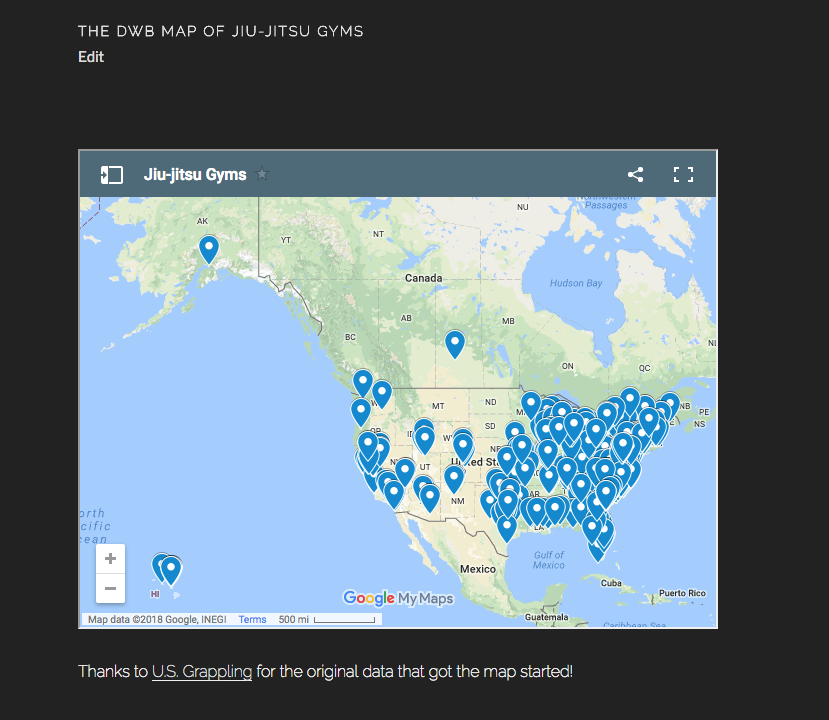I just want everybody to train jiu-jitsu. Everybody, everywhere.
That’s unrealistic, right? Sure, but every goal should start out unreasonable. If you start by telling yourself you’ll be happy with a 30 percent successful outcome, you’ll hit a lot of targets, but you’ll also shortchange your potential a fair bit.
Sure, it’s impossible to convince every single person I meet to train jiu-jitsu with a 100 percent success rate. Let’s talk about a tinier success rate, then — let’s say that rate is one percent.
Imagine your community is a mid–size city, somewhere between the average American town population of 20,000 and, say, 100,000. Think of between 2,000 and 10,000 people actively doing jiu-jitsu just in the town where you live. How many gyms could that support? How many Brazilian Jiu-Jitsu tournament competitions, MMA fights, superfight events, seminars? How many fun community events that also inspire people to train?
Think of the benefits if even one percent of the population in your community trained. You’d have a bunch of happier, tougher, more well-adjusted (both in the mental and spinal sense) people. Those are benefits to individuals, but there would also be community benefits. We’d also all have a lot more training partners, events to attend, bigger divisions in competitions, and resources available to continue progress. The benefits to training BJJ are considerable; the benefits of getting more people to train are exponential.
This brings us back to goals: our goals should be ambitious, but also have some realism to them. As someone who has always loved competition, I plan to keep competing until I die — but a very small subset of people have a shot at winning the adult world championships. That’s not my goal.
My goal — personally, but also through various jiu-jitsu projects — is to spread jiu-jitsu to as many receptive people as possible. Although jiu-jitsu is a niche practice right now, it’s a mistake to think that there is a limited pool of people who might be interested in, try, and fall in love with the art when given the chance. When I started, I was a small, mid-30s non-athlete with no real martial arts aptitude. People who knew me at 34 and lost touch with me are shocked I’d even try something like this. Now, there’s nothing else I’d rather be doing.
There are a lot of people out there like this, and I want to make sure they have access to training.
As someone who just returned to the Pacific Northwest after a decade away, and someone who traveled to train a bunch, I believe in Dave Camarillo’s maxim: “train with everyone.” No one of us is as smart as all of us, and we all learn when we drop in at other folks’ gyms. Plus, it’s more fun! Cross-pollination of backgrounds and experiences leads to better training, and more fun — which I think is exciting both for regulars and for new people who might not yet know they love this stuff.
Around the world, you’ll find people who share this perspective. BJJ Globetrotters is one excellent example of a community where people care about training for the joy, the knowledge and the experience. My instructor, Seth Shamp of Triangle Jiu-Jitsu, drilled the fundamentals into us but also made clear that our jobs as students were to learn as much as we could from everyone. A few other specific gym examples come to mind, too: Cody Maltais at Elevate MMA and Brad Acosta at TFTC Academy in Cary, NC, who regularly host other students and instructors — including instructors that don’t specialize in the school’s main discipline. Elevate has boxers, wrestlers, yoga and Kinstretch practitioners coming in — seminars that sometimes don’t appear to have a direct impact on mixed martial arts performance. One important point: often they do have significant benefits. A more important point: you can’t always predict what’s going to animate people about training.
An open minded gym allows new people more points of entry. In some places I travel, I see rigid attitudes about who is allowed to train where and what is and is not worth knowing. There is certainly nothing wrong with having a focus, but I find that this is often rooted in a scarcity mentality — the idea that gyms should be in express competition with each other.
If we treat “people who train” as a scarce, finite resource, we’ll always shortchange jiu-jitsu’s potential to change lives. But if we have an abundance mentality — an attitude that says the population of people who train can expand, at least to one percent of the larger community — jiu-jitsu can grow exponentially. And so can our communities of friends, students and training partners. It matters less to me where these people train (at what gym, with what team, etc.) than that they’re training, improving their lives, and benefiting themselves as well as the broader BJJ community.
Nobody owns jiu-jitsu. But everybody can benefit from it. That’s my unreasonable goal.


This is 100% our goal as well. I think a lot of bjj schools are constantly trying to get attention from more accomplished grapplers, that they forget that 99 percent of people in the world will never even put on a gi, so it’s those guys we should be targeting if we really believe I the “jiu-jitsu for everybody” mantra. Looking forward to seeing your progress as it unfolds!